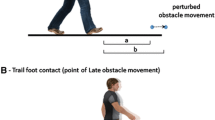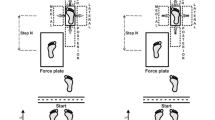Abstract
This study used environmental restrictions on foot movement to challenge the capacity of the central nervous system (CNS) to counter the lateral instability that arises after foot-lift during rapid triggered stepping reactions evoked by unpredictable postural perturbation. The objective was to determine the extent to which lateral stability could be regulated via modulation of the mediolateral (m-l) anticipatory postural adjustment (APA) that precedes foot-lift. A high frontal obstacle was used to double the required swing duration, and thereby increase the potential for the center of mass (COM) to fall laterally toward the unsupported side, during forward-step reactions. The capacity to use lateral step placement to recover lateral stability was restricted by means of lateral barriers. Six healthy young adults were tested. In obstacle-only trials, the APA was insufficient to prevent increased lateral COM motion during the prolonged swing phase; hence, lateral step placement was necessitated. However, when lateral stepping was obstructed, the CNS was able to upregulate the APA amplitude so as to prevent this increase in lateral COM motion. The swing foot was placed medially, with no detriment to clearing the frontal obstacle or recovering equilibrium. There was no change in step timing or anteroposterior (a-p) COM motion. While previous studies have suggested that the a-p COM progression may determine the extent to which the m-l APA is expressed or truncated during triggered stepping reactions evoked by unpredictable perturbation, the present findings demonstrate that prior knowledge of environmental demands can lead to predictive efforts to modulate the APA during such reactions. An apparent preference to underscale anticipatory efforts when lateral step placement is permitted suggests that the CNS may be acting to avoid some potential risk or cost associated with the execution of a large APA.
Similar content being viewed by others
Author information
Authors and Affiliations
Corresponding author
Rights and permissions
About this article
Cite this article
Zettel, J.L., McIlroy, W.E. & Maki, B.E. Environmental constraints on foot trajectory reveal the capacity for modulation of anticipatory postural adjustments during rapid triggered stepping reactions. Exp Brain Res 146, 38–47 (2002). https://doi.org/10.1007/s00221-002-1150-5
Received:
Accepted:
Published:
Issue Date:
DOI: https://doi.org/10.1007/s00221-002-1150-5




